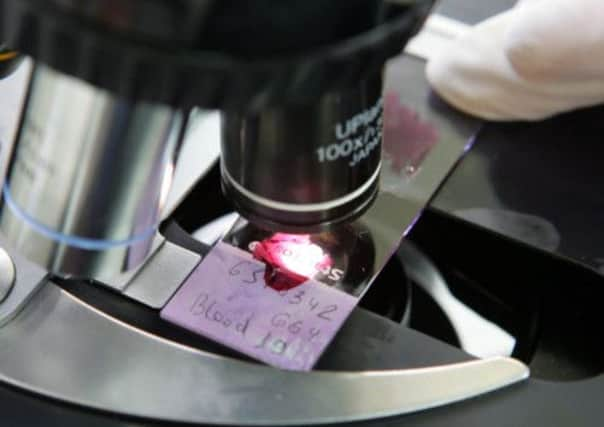Killer virus may spread with no symptoms


Scientists in Edinburgh, Cambridge, London and Saudi Arabia analysed the entire genetic make-up of the Middle East Respiratory Syndrome Coronavirus (MERS-CoV), seeking its source.
They found that human-to-human transmission was more complicated than expected, and raised a suspicion that infections are jumping repeatedly between animals and humans. The researchers, writing in the Lancet, also suggested there may be symptomless “carriers” spreading the virus unknowingly.
Advertisement
Hide AdAdvertisement
Hide AdIn the past year, 111 people have been diagnosed with MERS-CoV and 52 have died, including a few in the UK linked to travel to the Middle East.
The virus, which is similar to SARS, causes pneumonia and, sometimes, organ failure and other health problems.
Using advanced DNA analysis, the research team led by Professor Ziad Memish, from the Saudi Arabian ministry of health, and including Andrew Rambault, who is based at the College of Science and Engineering at Edinburgh University, analysed the genetic make-up of the virus collected from 21 patients.
This in-depth mapping of viruses allowed scientists to reconstruct how, when and where the virus has evolved and how it was being passed on. They found the virus evolved quickly, and that it was unlikely to have been transmitted from a single animal to human contact.
Instead, they said it appeared the virus had transmitted from an animal source to humans on several occasions, as well as transmitting between humans.
But this could be happening “under the radar” as some of those infected showed no symptoms. Professor Paul Kellam, senior author from the Sanger Institute in Cambridge, said: “Our findings suggest that different lineages of the virus have originated from the virus jumping across to humans from an animal source a number of times.”
So far, no animal with MERS-CoV has been identified in the Middle East or anywhere else. But some studies suggest that a common ancestor of the virus may have existed in bats.
Studies of other species which may be acting as a reservoir for the virus are ongoing, including camels, bats, goats, sheep, dogs, cats and rodents in Saudi Arabia and other Middle Eastern countries.
Advertisement
Hide AdAdvertisement
Hide AdProf Memish added: “Further studies need to be carried out. The animal source of MERS-CoV and the way that it is transmitted to humans is not yet known.
“This is critical for developing interventions for reducing the risk of transmission, defining the epidemiology and developing effective control measures.”
Despite the many questions remaining about the virus, the researchers said it was good news that there had been no cases reported linked to two mass gatherings attracting more than eight million pilgrims in Mecca since the discovery of MERS-CoV 12 months ago,
They said that “watchful surveillance and vigilance” was now required to monitor any further spread of the virus.
Vaccination hope in battle to beat leukaemia
Leukaemia patients could have their immune system “engineered” to fight the disease, research suggests.
University of Birmingham scientists discovered some people with leukaemia lacked an immune response to a certain class of proteins which could be restored through stem-cell transplants.
The discovery may lead to a vaccination against leukaemia for at-risk groups found to lack this vital immune reaction.
This could mean their own immune system would be activated to kill cancerous cells before the disease takes hold.
Advertisement
Hide AdAdvertisement
Hide AdResearcher Dr Mark Cobbold said: “These findings need to be confirmed, but could lead to new treatment options for patients with leukaemia or other cancers, or preventative vaccination for at-risk groups.”
Professor Chris Bunce, research director at Leukaemia and Lymphoma Research, said: “By pinpointing key antigens found only on the surface of leukaemia cells, this could lead to new ways of modifying patients’ own immune systems to attack only leukaemia cells or even stop them from developing in the first place.”